
Input Price under Perfect Competition and Imperfect Competition
Wages under Perfect and Imperfect Competition
Under perfect competition, the equilibrium wage rate is determined where demand for labor is equal to the supply of labor. In other words, under perfect competition, a laborer will get wages equal to its marginal revenue productivity in the long run.
In Fig. 9 units of labor have been measured on X-axis and wages on Y-axis. DD and SS are the Demand and Supply curves of laborers respectively. Both the curves intersect each other at point E which determines the wage rate OP in the market.
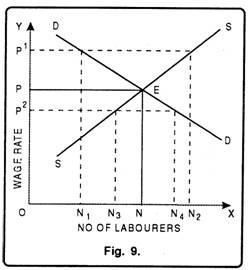 At this level of wages, ON units of laborers will get employment. Now suppose, wages go up to OP1. At this price, demand is ON1 and supply ON2. Since the supply is more than demand; it will lead to competition among laborers to get employment which in turn results in a decrease in the wage rate. On the other hand, if the wage rate falls to OP2, demand will be more than the supply. This results in competition among the producers to get the services of labor which in turn leads to an increase in the wage rate. Therefore, we may observe that equilibrium will be restored at that point where the demand curve of laborers intersects the supply curve of laborers.
At this level of wages, ON units of laborers will get employment. Now suppose, wages go up to OP1. At this price, demand is ON1 and supply ON2. Since the supply is more than demand; it will lead to competition among laborers to get employment which in turn results in a decrease in the wage rate. On the other hand, if the wage rate falls to OP2, demand will be more than the supply. This results in competition among the producers to get the services of labor which in turn leads to an increase in the wage rate. Therefore, we may observe that equilibrium will be restored at that point where the demand curve of laborers intersects the supply curve of laborers.
The study of the firm’s equilibrium can be studied in the following two time periods:
1. Short Run
2. Long Run
1. Short Run Period:
Short-run refers to a period in which it is not possible for a firm to fully equate the demand for and supply of a factor. Therefore, a firm in the short run may face three situations.
Supernormal Profit:
If at the OW wage rate, a firm employs as many laborers whose ARP is more than the prevailing wage, the firm earns supernormal profits. In Fig. 10 a firm at its equilibrium employs OX laborers. Here ARP i.e. PX is greater than the wage rate EX. Thus, the firm earns EP as supernormal profits
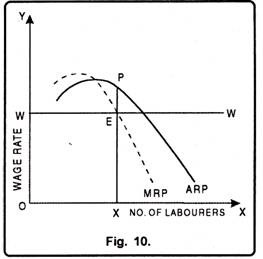
Normal Profit:
A firm enjoys normal profits if ARP is equal to the wage rate. In Fig. 11 when a firm employs ON several laborers, their ARP is EX which is equal to prevailing wage rate OW. Thus, the firm gets only normal profits.
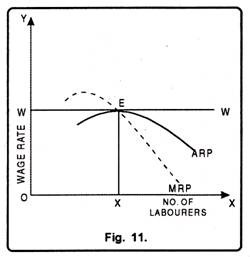
Losses:
A firm incurs losses, if at prevailing wage; a firm employs the number of laborers at which their ARP is less than the prevailing wage rate. In Fig. 12 when a firm employs OX laborers, their ARP = PX is less than their wage rate OW. Thus, the firm has to incur losses equal to EP.
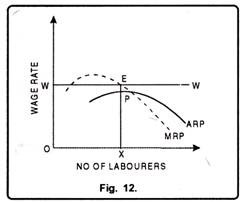
2. Long Run Period:
In the long run, a firm earns a normal profit. A firm will be in equilibrium where ARP is equal to MRP. In Fig. 13 when a firm employs OX laborer ARP is equal to MRP.
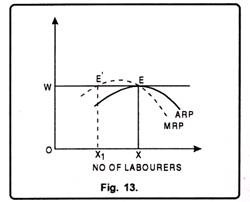
Wage Determination under Imperfect Competition:
In the world of reality, there exists an imperfect competition rather than perfect competition. Therefore, Mrs. Joan Robinson and Prof. Pigou gave the wage rate determined under the conditions of imperfect competition.
The wage rate determination can be explained fewer than two heads:
(a) Perfect competition in product Market and Monopsony in the Labour market.
(b) Monopoly in the product Market and Monopsony in Labour Market.
These are the conceptual notes of Input Price and Employment under Perfect Competition and Imperfect Competition
You may also like: Input Pricing under Bilateral Monopoly

Leave a Reply